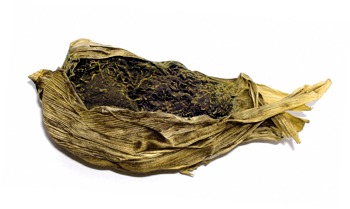Diseases
Sorosporium reilianum (Kuehn) McAlp. - Head Smut
Systematic position.
Class Basidiomycotina, order Ustilaginales, family Ustilaginaceae, genus Sorosporium.Synonyms.
Sorosporium holci-sorghi (Riv.) Moesz, Sphacelotheca reiliana Clinton.Biological group.
Obligate parasite.Morphology and biology.
The fungus S. reilianum affects panicles and ears of corn. Infected panicles turn into compact mass of black teliospores, and infected ears turn into black conoid lump of filaments and spores of the fungus. The spores can keep among filaments till maturing of corn. The infected plants are characterized by delayed growth, forming bushes and being often ugly. Teliospores are main source of the infection, keeping in soil or on grain surface for a long time. Teliospores are reddish brown to black, globose to subglobose, finely spinous. At early stage of sporogenesis the teliospores are aggregated in sori being 70-100 mkm in size. After wintering the teliospores germinate, forming dikaryotic mycelium. Corn seedlings are very susceptible to the pathogen at early stages of plant development. Dikaryotic mycelium penetrates into corn seedlings through coleoptile. The mycelium gradually moves along stem and reaches ear and panicle, converting them into smut sorus. After maturing in smut sorus the spores are dispersed, falling on soil or on ears and grains.Distribution.
The disease agent was first discovered on sorghum in Egypt, then on corn in Italy. Special experiments show that the fungus isolated from sorghum cannot infect corn and the fungal isolates from corn cannot infect sorghum. Thus, there are two specialized forms of the species, S. reilianum f. reilianum infecting sorghum and S. reilianum f. zeae infecting corn. In Russia the latter form is wider spread, affecting strongly corn. The Head Smut is a disease of southern regions of Russia. The disease is significant in Kuban. region and Alania, being insignificant in Stavropol Territory. In 1980-s the disease spreading in Ukraine reached 21.6%, and yield losses reached 2-8% every year. In 1980-90-s the infection distribution on corn was 1.6-30%, and yield losses reached 35%. At the end of 1990-s the Head Smut was widely spread in Primorskii Territory of the Far East. In commercial corn sowings the Head Smut distribution was 1.0-25%, yield losses reached 1.1-40.0%.Ecology.
Eco-geographic populations of the Head Smut differ in pathogenicity and hydrothermic requirements. The extent of infection development depends on dates of corn sowing. Optimal dates of sowing decrease the infection level in 3-4 times in comparison with late sowings. The infection occurs mainly at high temperature. Optimal temperature for the disease development is 28-30.. Therefore the disease is spread in southern regions with warm spring and hot summer. The fungi can keep viability 4-5 years.Economic significance.
Yield losses are 15-20% on fields where corn is grown during many years, and they can reach 40% in some farms where unsteady hybrids are grown on the same field during several years. Latent form of the disease is known, when the parasite develops quietly, causing depression of the plant growth and absence of ears. The following protective measures must be used: crop rotation (return of corn on the same field in 3-4 years), removal of residues from field, treatment of seeds by fungicides, optimal dates of sowing.Related references:
Bzikov M.A., Dyarikov Y.P. 1971. Head smut of corn and control of the disease. Kukuruza 10: 28-29 (in Russian).Chaika A.K., Martynyuk T.D. 2001. Damage of smut diseases to corn in Primorskii Territory. Kukuruza i sorgo 5: 19-22 (in Russian).
Grisenko G.V., Dudka E.L. 1976. Ecological and geographical populations of Sorosporium reilianum (Kuehn) Mcalp. and their pathogenicity to corn. Mikologiya i fitopatologiya 10(5): 385-389 (in Russian).
Kalashnikov K.Ya., Shapiro I.D. 1962. Pests and diseases of corn. Leningrad: Sel.khozgiz, 189 p. (in Russian).
Karatygin I.V. 1986. Agents of smut on cereals. Leningrad: Nauka, 112 p. (in Russian).
Nemlienko F.E. 1957. Diseases of maize. Moscow: Sel.khozgiz. 230 p. (in Russian).
Rabichuk A.V., Matichuk V.G., Yazadgi P.P., Pomudyak I.G. 1990. Head smut of corn. Zashchita rastenii 4: 20 (in Russian).


